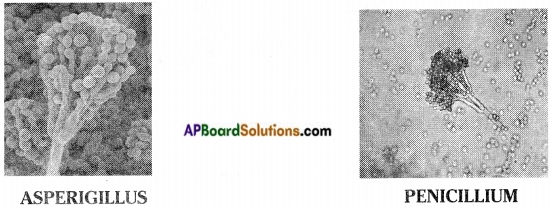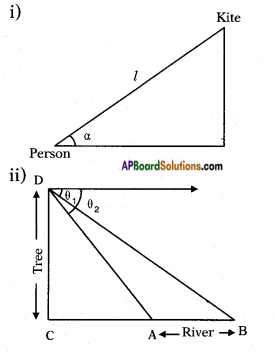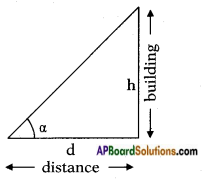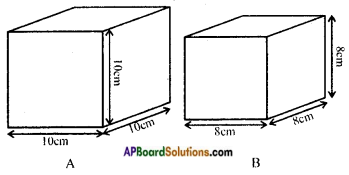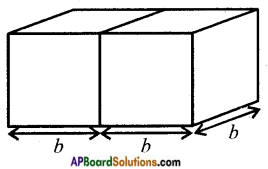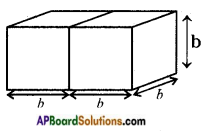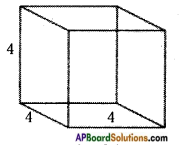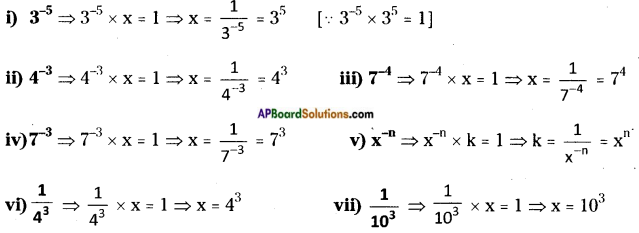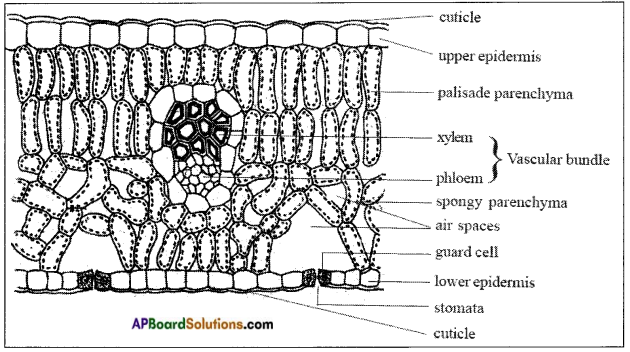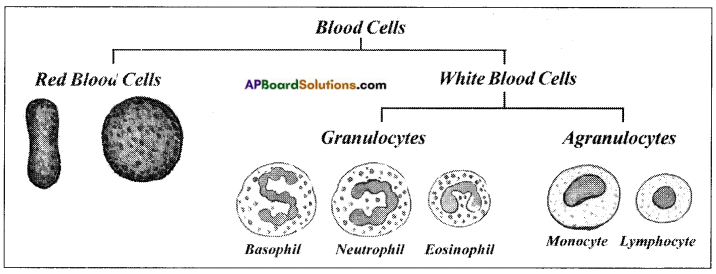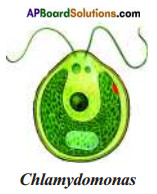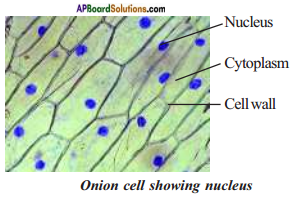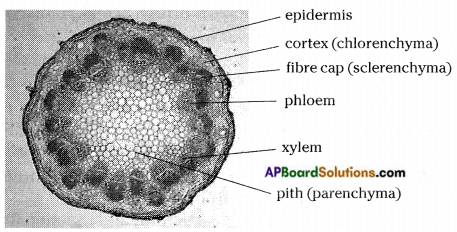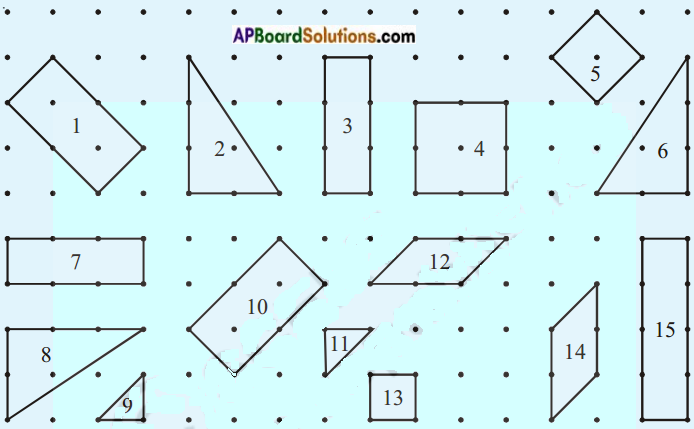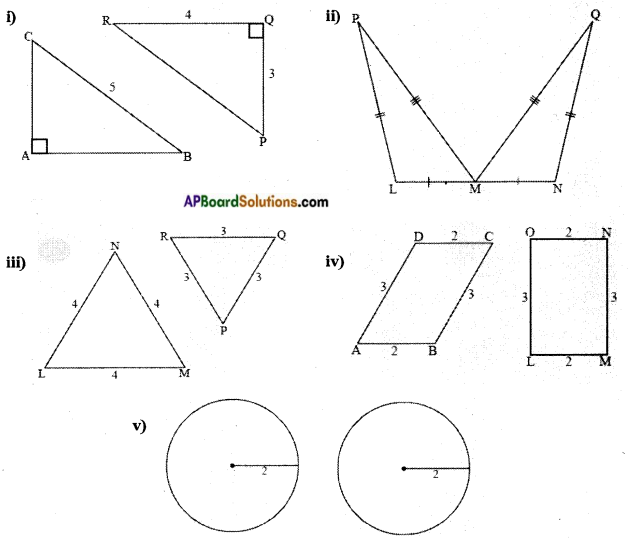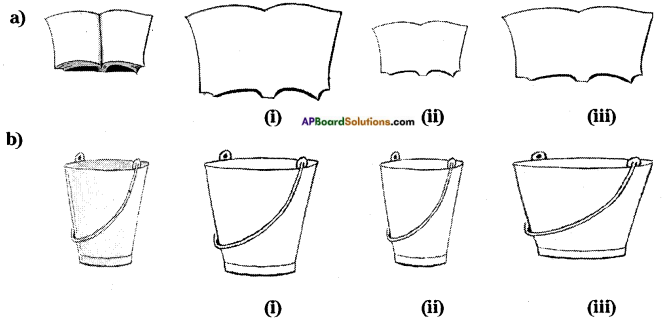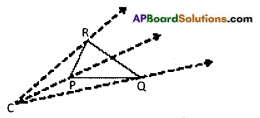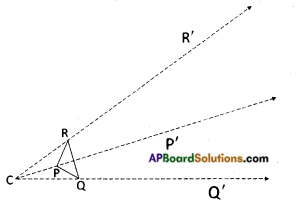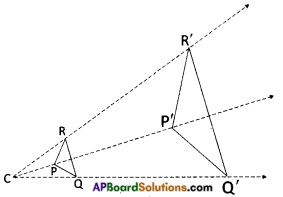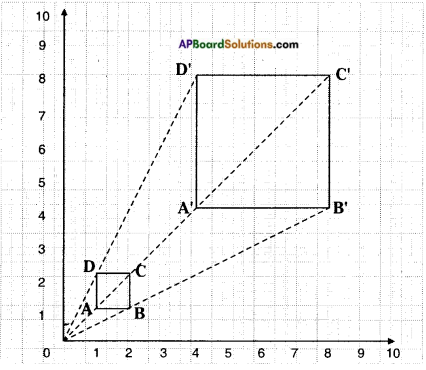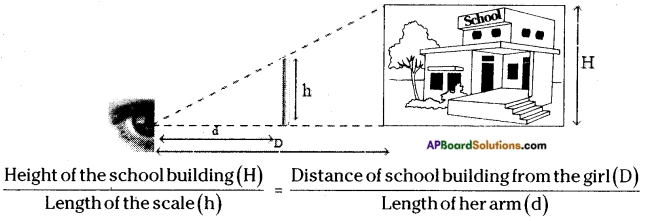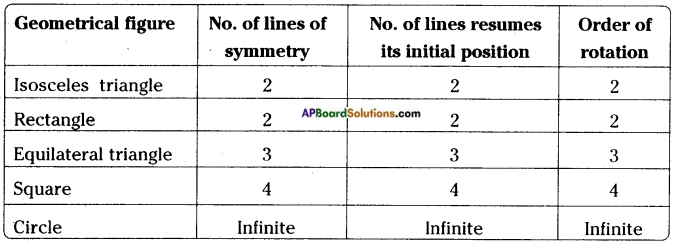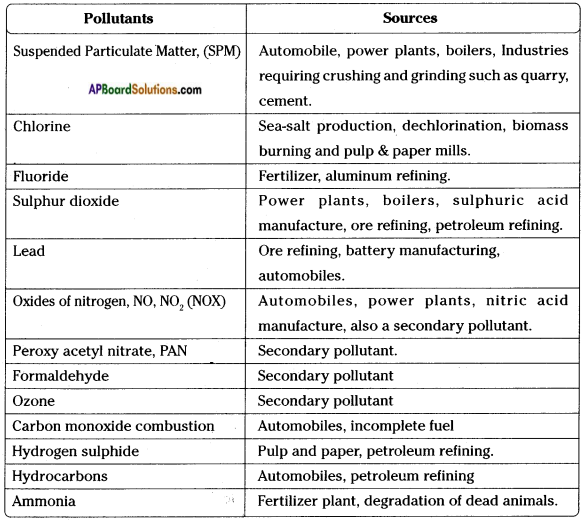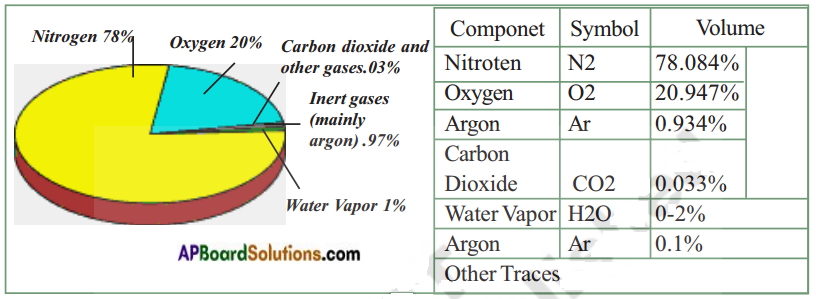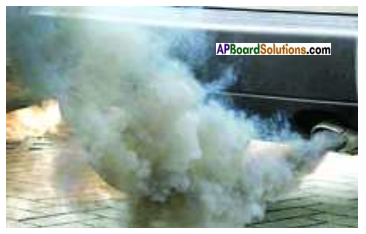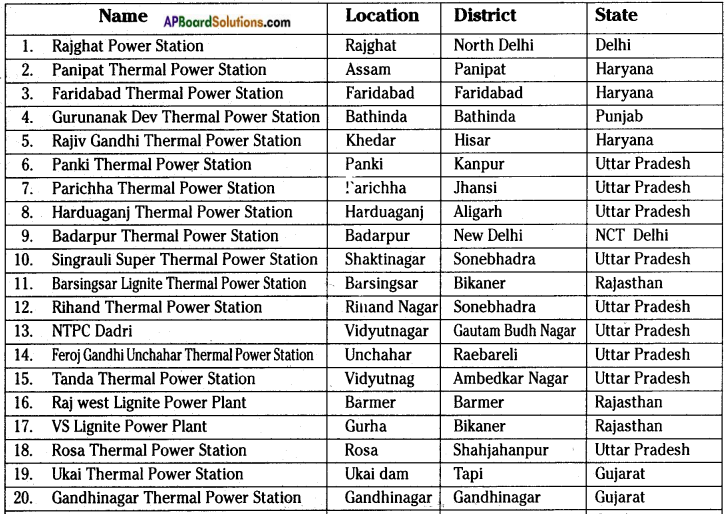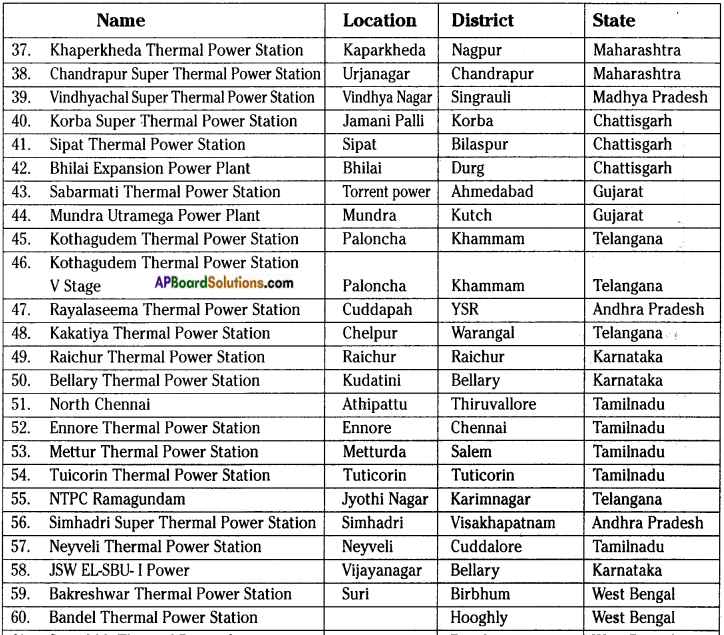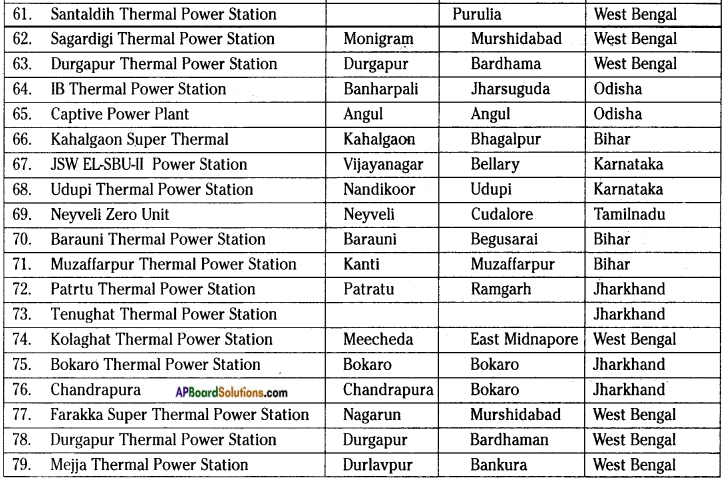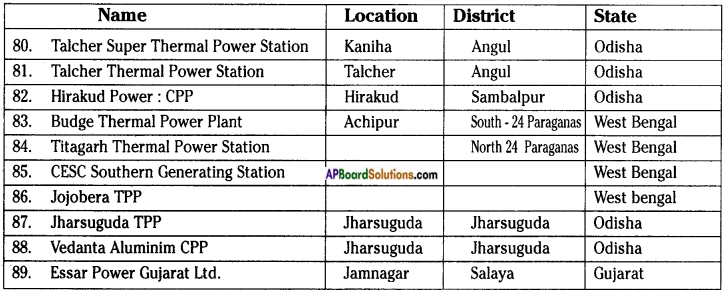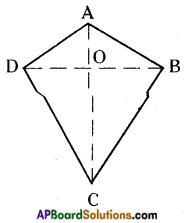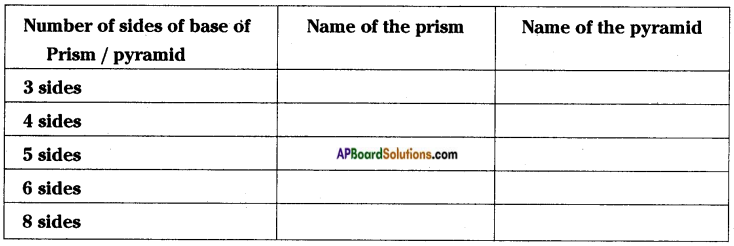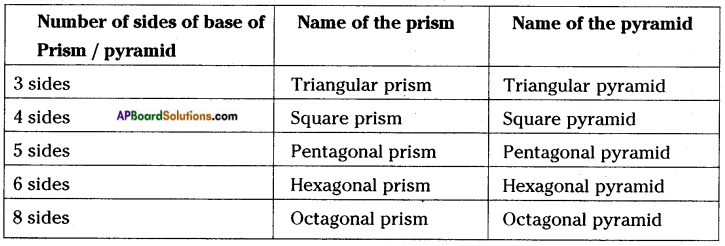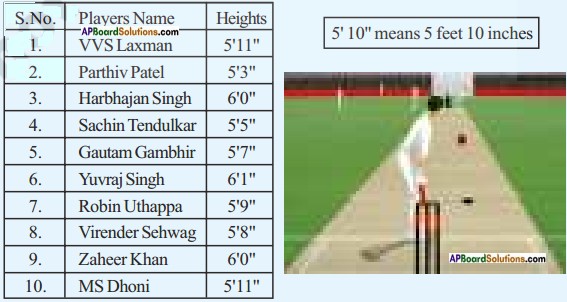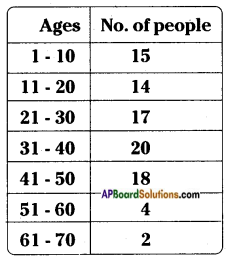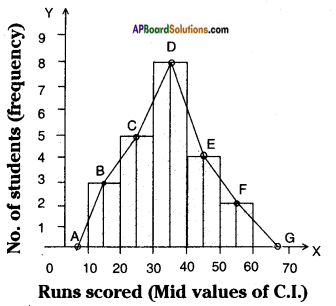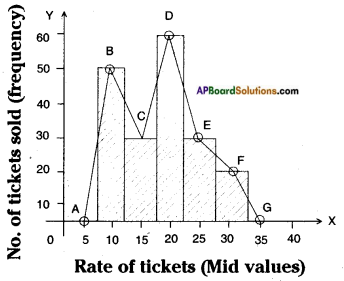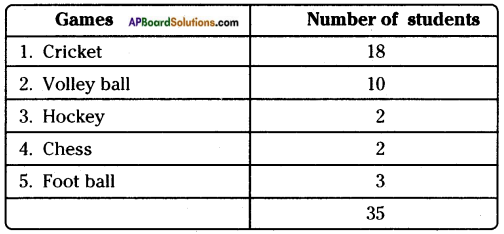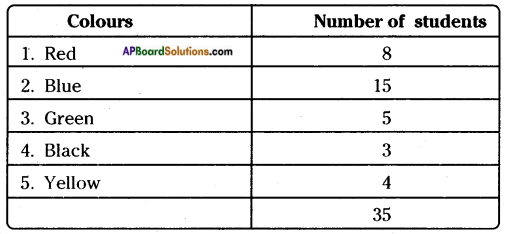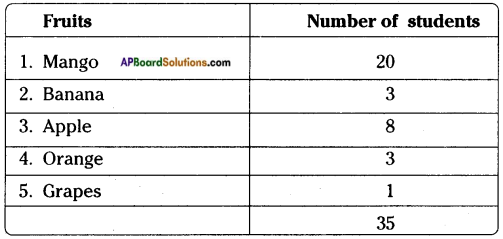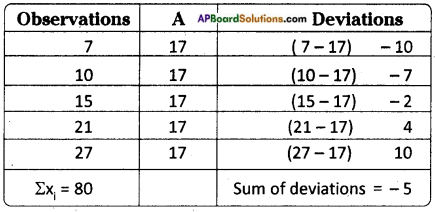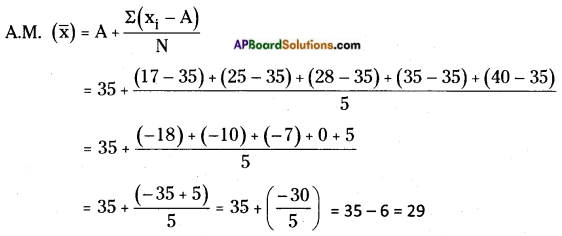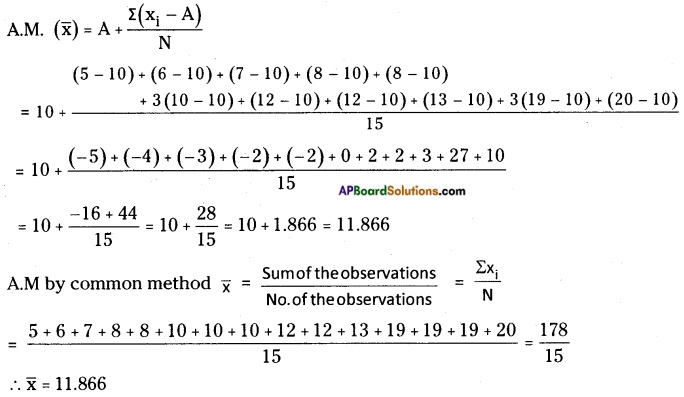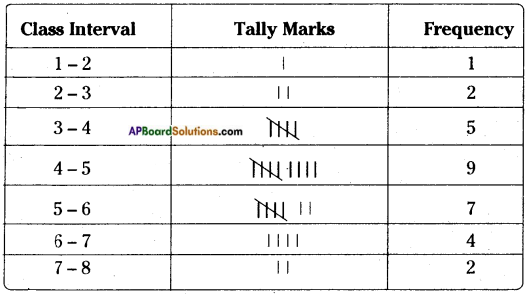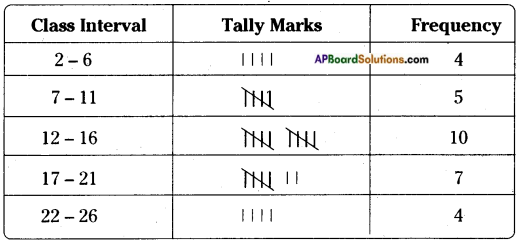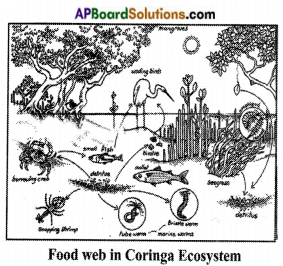AP State Syllabus AP Board 8th Class Biology Solutions Chapter 6 Biodiversity and its Conservation Textbook Questions and Answers.
AP State Syllabus 8th Class Biology Solutions 6th Lesson Biodiversity and its Conservation
8th Class Biology 6th Lesson Biodiversity and its Conservation Textbook Questions and Answers
Improve Your Learning
Question 1.
Read this and answer the following questions.
Answer:
Biodiversity – 2050.
A news item on Biodiversity discussed by Conference of Parties (CoP) -2012- Hyderabad says in the next four decades the earth’s natural resources will be limited to grass lands, mountains, ice and arid and semi arid plains.
By 2050 the loss of Biodiversity will lead to unprecedented. Climate change would be the key factor. Nearly 1.3 million natural ecosystems will be without any original species.
(The coloured areas are indicators of biodiversity loss. The red areas show maximum biodiversity loss.)

a) What does the areas with colour codes indicate?
Answer:
The coloured areas are the indicators of Biodiversity loss.
b) Which areas show maximum biodiversity loss?
Answer:
The red areas show maximum biodiversity loss.
c) Which areas show minimum biodiversity loss?
Answer:
The blue areas show minimum biodiversity loss.
d) From 2010 – 2050 what difference do you find in the state of biodiversity?
Answer:
In the few decades earth’s natural areas will be limited to grass lands, mountains, ice and arid and semi arid plans. Nearly 1.3 million natural ecosystems will be without any original species.
e) So what steps would you suggest to conserve our biodiversity?
Answer:
Utilizing the forests resources judiciously without effecting the ecosystems. So that we can have a sustainable development in the forests and the biodiversity can be conserved for future generations.

Question 2.
How can you say that forests are biosphere reserves? Give reasons.
Answer:
- Forests are the natural habitates for many types of plants (flora) and animals (fauna).
- Plants are primary producers as they provide food for entire human population and all other living organisms on earth.
- Every part of the plant is used by man and animals in their daily life, and also some of the exudates are used by man.
- We get cereals, pulses, oil seeds, sugars, spices, drugs, timber, fibres and coir from plants.
- In addition to this products like rubber, resins, fruits, vegetables, dyes, etc. are obtained from plants.
- Variety of animals live in the forests. Major products obtained from animals are meat, milk hair and skin.
- Primitive man obtained his food requirements primarily by hunting of animals in the forests.
- The skin of animals like tiger, lion, leopard, deer, snakes and ivory from elephants are very valuable.
- Thus we can say that forests are biosphere reserves.
Question 3.
What do you understand about the terms (a) extinct (b) endangered (c) endemic?
Give examples.
Answer:
a) Extinct: When animals vanish for ever from the earth it is said that the species has become extinct. E.g.: Sparrow, vulture.
b) Endangered : It is a warming signal about the organisms whose numbers have declined rapidly and the species might be wiped off from the earth in near future. Such organisms are called endangered species. E.g.: Lion, red fox, loris, wild cat, vulture.
c) Endemic: Plants or animal species found restricted to a particular area of a country are called endemic species. E.g.: Tiger, peacock, kangaroo, kiwi.

Question 4.
a) Extinct: When animals vanish for ever from the earth it is said that the species has become extinct. E.g.: Sparrow, vulture.
b) Endangered: It is a warming signal about the organisms whose numbers have declined rapidly and the species might be wiped off from the earth in near future. Such organisms are called endangered species. E.g.: Lion, red fox, loris, wild cat, vulture.
c) Endemic: Plants or animal species found restricted to a particular area of a country are called endemic species. E.g.: Tiger, peacock, kangaroo, kiwi.
Answer:
- Some birds live in the same habitate throughout the year. Other birds which don’t have permanent nestlings join into small flocks and move from one region to the other for food and shelter called as ‘migration’ and such birds are called migratory birds.
- Primary motivation for migration appears to be food. Also longer days of northern summer provide extended time per breeding birds to feed their young ones.
Question 5.
Identify the endemic and endangered species and write them below the pictures.
Answer:

Question 6.
What is the need of conducting biodiversity meet ? Collect information about these meetings when and where it was conducted and its agenda also.
Answer:
The need of conducting biodiversity meet is
- Managing biodiversity in transboundary landscapes in Hindukush Mountains.
- Conserving high altitudes wet lands of the Hindukush Himalayans.
- Operationalizing nagoya protocall in South Asia.
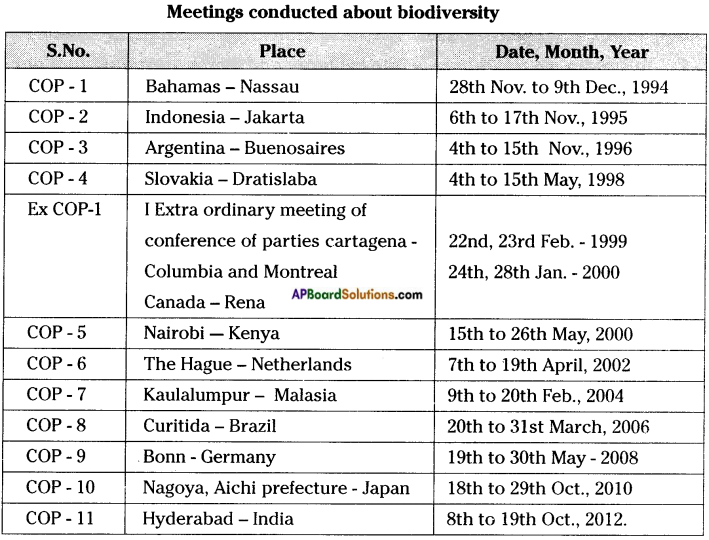

AGENDA
- Conservation of Biodiversity.
- Sustainable use of components of Biological diversity.
- Fair and equitable sharing of benefits arising out of the utilization of genetic resources.
33 Decisions were taken at cop – 11, Hyderabad among them some are given below.
- Status of Nagoya protocol an axis to genetic resources and equitable sharing of benefits.
- Review of progress in implementation of strategic plan for Biodiversity – 2011 – 20 and Aichi biodiversity targets.
- Review of implementation of the strategy for resource mobilization including establishments of targets.
- Financial mechanism.
- Cooperation with other conventions International organization and initiatives.
- Business and Biodiversity.
- Engagement of other state holders major groups and sub – National authorities.
- Progress report on gender main streaming
- Periodicity of meetings.
Question 7.
Nowadays we find animals like leopards and bears intruding into our living places. What may be the reason for this?
Answer:
- Forests are the living places for wild animals. Animals can get plenty of food, shelter from the shade of trees and they feel secure in the forests.
- People are so greedy that they cut down the forest areas for logging of wood, to increase agriculture, and for human habitations.
- They clear the forests to construct, thermal power stations, industries and many buildings which leads to destruction of forests.
- Due to deforestation, nowadays the animals like leopard and bears, lost their food and shelter, to satisfy their hunger and to keep themselves alive, they intruding into our living places.
- To escape from hunters and from climatic conditions because of deforestation, is may be one more reason, for the animals coming into our living places.

Question 8.
Make a list of animals/birds seen now and 30 years ago. Take the help of your elders. Write few reasons for their disappearance.
Answer:
- List of Animals and Birds: Lion, Tiger, Jackel, Fox, Wolves, Deer, Monkeys, Hyena, Squirrel, jungle foul etc. Birds like Crow, Pigeon, Peacock, Koel, Parrot, Flemingo, Mynah, King Fisher, Emu, Migratory shore birds etc.
- The endangered species of plants and animals of India are:
Lion, Red fox, Single horned (Rhinoceros), Vulture, Spotted chital deer, Loris, Black spider monkey, wild cat, cycas, Rauvolfia serpentine, Nepenthes, Sandle wood tree.
- These species include mammals – Indian cheetah, Japan Rhinoceros and Sumatran Rhinoceros. Some species of birds of gone extinct in recent times – including pink headed duck (Rhodonessa caryophyllacca) and Himalayan quail (Ophrysia superciliosia)
- Warbler (Acrocephalus orinus) – Rampur in H.P was rediscovered after 139 years in Thailand.
- Based on the case study we find that many animals that were found earlier are not found now.
- The reason for this is exploitation of land and forest resources by humans, along with hunting and trapping for food and sport has led to the extinction. Feeding of Diclofenac treated cattle is the reason for disappearance of vulture.
Question 9.
Select an area in your locality. Observe the animals (living and visiting) for a day. Prepare a list and plot a graph.
Answer:
The animals in our locality:
- Dog
- Cat
- Rat
- Mouse
- Bandicoots
- Squirrels
- Frogs
- Lizards
- Garden Lizard
- Monkeys
- Buffaloes
- Goats
- Donkeys
- Mongoose
- Snake
- Sheep
- Fish
- Tortoise
- Rabbit
- Parrot
- Crow
- Hens
- Koel
- Pigeon
- Butterflies
- Houseflies
- Dragonflies
- Mosquitoes
- Honey bee
- Cockroach


Question 10.
When tree is considered as an ecosystem, record the flora and fauna connected with it.
Answer:
Flora and Fauna of a tree.
Flora:
- Grass,
- Trida (shrub),
- Datura (Herbs),
- Creppers,
- Mosses,
- Fungi.
Fauna: Squirrels, Butterflies, Dragonfly, Mosquitoes, Birds, Snakes, Ants, Catterpillers, Beetles, Buffaloes, Goats, Human beings, Mouse, Lizard.
Question 11.
Browse through the internet or books on wild life and gather information on birds sanctuaries in India. Prepare a list of birds migrating to India.
Answer:
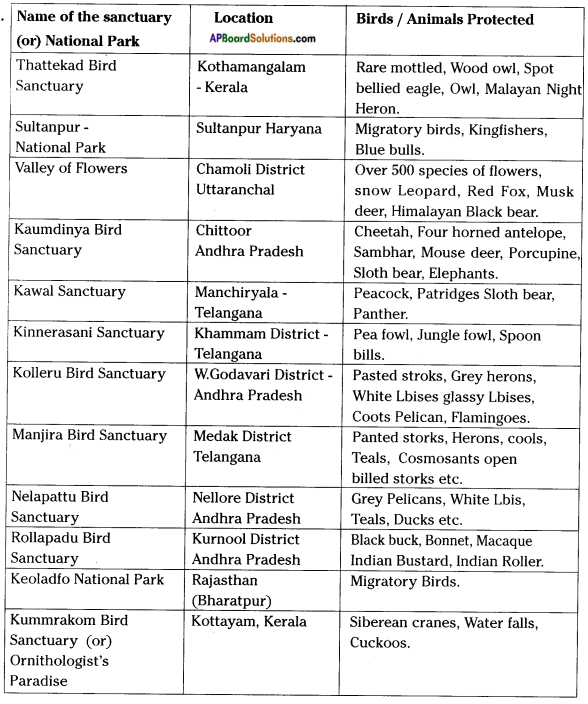
Birds migration to India:
- Siberian cranes
- Greater flamingos
- Ruff
- Black winged stilt
- Common teal
- Common Green Shark
- Northern Pintail
- Yellow wag tail
- White wag tail

Question 12.
Visit local forest office and collect the data of local flora and fauna.
Answer:
Horticultural Resources: Guava, Mango, Papaya, Sapota, Banana, Coconut, Citrus.
Major oil seeds: Groundnut, Sunflower, Oil palm.
Major food crops: Paddy, Jowar, Ragi, Bazra, Maize, Green gram, Red gram, Black gram.
Commercial crops: Sugarcane, Jute, Chillies, Cotton, Turmeric.
Forest based Resources: Plantation of Eucalyptus Trees, Ponuku wood, Casuarina,
Subabul, Jatropa, Pongamia (bio – diesel plantation).
And also:
Vegetables, flowers, plantation crops, spices and medicinal plants, aromatic crops.
They occupy 6517, 177, 4440, 14315 and 369 hectors respectively in Khammam District.
Local Fauna:
Life Stock Resources: Poultry, Dairy form.
Marine Resources: Fish, Prawn.
Animal Husbandary: Plough animals, Dairy animals like Cow, Buffaloes, Sheep, Goat, Pig.
Forest resources:
- Panther, Hyena, Jungle cats, Foxes, Bears, and Carnivores, Mammalian are found.
- Deer, Spotted deer, Sambar, Black buck and other Herbivorous animals found in inland forests.
- The district has a large number of murrah buffaloes and cows.
- Migrant grey billed pelican is a protected bird in Kolleru lake and Pulicat lake.
Question 13.
Where do you find most of the biodiversity on the earth? Draw A.P map showing maximum biodiversity areas.
Answer:
- In areas with sufficient amount of water, a wide variety of plants ranging from grasses to tall trees are seen.
- Most of the forests are seen in these areas.
- As there is sufficient vegetation, there will be a large number of herbivorous animals. Carnivorous animals which feed on the herbivores are also found in these regions.
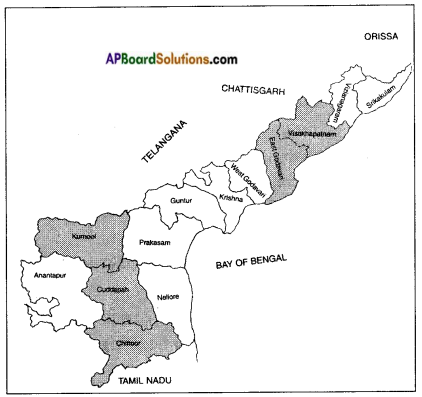
- Generally there is a increase in biodiversity from poles to trophies. Thus localities at lower lattitudes have more species than localities at higher lattitudes.
- Ultimate factor behind many of the other factors is greater mean temperature at the equator.

Question 14.
What do you understand by biodiversity? How can you say variations are present in them?
Answer:
The word biodiversity is a contraction of biological diversity. It is commonly used to describe the number variety and variability of living organisms. This very broad usage embracing many different parameters, is essentially a synonym of LIFE ON EARTH.
- The whole world has wide variety of living organisms we can see both invisible (microbial) and the visible world around us are diverse.
- Different microorganisms like algae, fungi, bacteria, viruses etc., and also the micro-arthropods. There is diverse among microbes.
- There are different variety of plants like grass, herbs, shrubs, creepers, trees etc. Among the individuals also there are variations like height, colour and size of flower and fruits.
- We find variations in animals even though they are similar kind. We find differences in colour of fur, nails, claws or hoofs etc.
- Among birds we can see variations in their feathers, feet, crown, tail etc.
- As all the humans belong same genus but there is variation in their hands, fingers, toes, nails and hair, height and shape. We can even see variation in the texture of skin dry, oily, smooth or rough. Whether they are twins also we can find variations among them.
Question 15.
Most of our biodiversity is being lost due to human activities. Suggest few ways to protect them.
Answer:
Most of our biodiversity is being lost due to human activities like logging of wood, increased agriculture, increased human habitation and pollution etc. Man has realised this mistake before it was too late. Government of India also realised the importance of wild life and initiated several programmes to preserve wild life in the country and the wild life act was passed in 1972.
Efforts towards conservation:
- Activities leading to deforestation have been declared as illegal activities and severe punishments have been imposed.
- Pouching of birds and hunting their eggs are prohibited.
- Usage of pesticides should be minimised. Usage of biological control methods of pests should be maintained.
- Efforts to be made to substitude chemical fertilizers with more (natural) bio fertilizers.
- Pollution from the industries should be reduced.
- Automobiles should be designed to reduce pollution.
- Reforestation programmes will be conducted.
- Gardens, parks, lakes and zoos should be developed.
- National parks, wild life sanctuaries, where wild life is protected, have been created.
- Collection, marketing and selling of forest products such as sandal wood, ivory by private parties is banned and is taken up by the Government.
- Construction of cell phone towers which produce radiation, should be in greater height, so that they should not be reachable to the birds.

Question 16.
When you see a park, sanctuary or a zoo with many kinds of plants and animals, how would you express your happiness? Write a few lines on them.
Answer:
- Imagine a forest with a carpet of wet leaves littering the ground, the flowers on the trees, we can hear the water drops, sounds of insects, birds chirping and perhaps the distant screech of a monkey – the place picturing is a park, a sanctuary or a zoo. Which gives pleasure to us.
- These are the homes for many plants and wild animals – and also decorate the world. Any of them are airy and shadowy places.
- These dwelling places of plants and animals give us happiness. When we are in distress. They give relax – when we feel tired. They give us enjoyment when playing with our friends and they give good health – when we fall sick as they give fresh air and are the lungs of the world.
- They maintain ecological balance in the environment where we live.
- We notice the pet dog licks our feet, wags it’s tail, sits near us and walks with us we feel the affection, which gives pleasure mentally.
- Like this we can experience many situations plants and animals as they are the partners of our environment. So be kind towards them and protect the environment. By maintaining eco – friendly activities.
Question 17.
Prepare an essay to give a talk on biodiversity and conservation.
Answer:
- The existence of biodiversity in nature teaches us that every plant and animal whether useful or not has right to exist on earth.
- Every organism is a part of our ecosystem. Loss of any organism endemic or otherwise effects the food chain and food web of that ecosystem, which has impact on the world biodiversity.
- Hence if we want to protect the biodiversity on our planet, first we must be a part of conservation and then make other aware of it because today we see extinction of some species tomorrow it could be our species.
- Conserving the biodiversity in a wider prospective is utilizing the forest resources judiciously without affecting the ecosystems so that we can have a sustainable development in the forests and the biodiversity can be conserved for future generations.
- Nature is for human’s need, not for his greed. If we protect nature, it protects us.

Question 18.
Rani said conservation, of biodiversity starts from our home. Is she correct? How do you support Her? What will be your action for this?
Answer:
- We live in houses that protect us from heat, cold and rain etc.
- We keep some animals and birds as pets in our houses. We also grow some plants which give us fruits and vegetables.
- Thus we can say that our house is also a habitat. Several animals like dogs, cats, goats, cows, birds, hens, ducks, pigeons, spiders, ants, cockroaches live with us.
- Plants like money plant and some crotons are also kept inside our house.
- We know that every bit of effort towards conservation helps. If we take due care of plants growing around us, we may not be adding a forest, but adding to greenery around us which is essential for our own existence.
- So Rani is correct. Conservation of biodiversity starts from our house.
Question 19.
When we take steps towards conserving the tiger, what are the other things that have to be conserved?
Answer:
- When we take steps towards conserving the tiger we have to conserve the other flora and fauna related to the tiger.
- If a tiger has to be saved it’s food web should be protected.
- The tiger depends for food on deer and many other herbivores.
- If the tiger disappears, the deer and other herbivores population will increase and that would affect the flora of the area.
- All organisms in nature influence each other in some way or the other. So we need to protect all of them.
Question 20.
Prepare some slogans or a pamphlet to make aware of people about conservation of biodiversity. (OR)
Prepare two slogans to conserve biodiversity in your area.
Answer:
- Save tree – Save other lives too.
- Save the lungs of the earth.
- Be kind towards biodiversity.
- Reduce pollution.
- Protect Nature, it protects us.
- Nature is for human’s need not for his greed.
- Hunting of wild life is a crime.
- Forest is our life.
8th Class Biology 6th Lesson Biodiversity and its Conservation InText Questions and Answers

Question 1.
Rampachodavaram: East Godavari District, 60-70 years back Rampachodavaram had dense forest with a rich heritage of wild life. These forest extended to border areas of Aswaraopet of West Godavari district. It was an abode for wild animals like tigers, leopard, deers, hyenas (kondrigallu), foxes, wild boars (adavi pandi), bears, pythons, cobras, porqupines (mulla pandhi), owls, hares, monitor lizard (udumu) scorpions, geremandals (like the desert spider) etc.
After the erection of mines (colour soil) and other industries, human activities increased. Then many buildings, roads and stone quarries have come into exist¬ence. Forest area was cleared and so several organisms started disappearing.
Though an area near Maredumilly, Addateegala (very close to Eleswaram) was once known as Tiger valley, shows no signs of tigers now. Animals like foxen, deers are also not seen these days.
Now there are several human settlements in the area. Some areas of less dense forests with animals like pythons, cobras, deers, scorpions etc., are commonly seen. Bears are rarely found. Peacocks have been sighted recently.
The above case study explains you the need of conservation of biodiversity.
a. What is the difference between the situation regarding types of animals present 70 years ago and now?
Answer:
70 years ago Rampachodavaram had dense forest with a rich heritage of wild life. Now no animals are not seen. Now there are several human settlements in that area.
b. What might have happened to tigers of Rampachodavaram?
Answer:
After the erection of Mines (colour soil) and other industries, human activities increased. Many buildings, roads and stone quarries have come into existence. Forest areas were cleared and so several organisms started disappearing.
c. Do we find tigers any where else in our country?
Answer:
Tigers are found in other parts of our country and the world as well.
d. Peacocks love eating snakes. Can you guess why they dwell in this place?
Answer:
We can find snakes in desert areas. Peacocks love eating snakes. So they dwell in this place where it finds it’s food (snakes) plenty.
Question 2.
Is there any extinct species in your area ? Name them and write a note on them.
Answer:
Sparrow, Vulture.
i) Over use of pesticides and radiation from cell phone towers led to extinction of sparrow.
ii) By feeding of diclofenac – treated cattle led to extinction of vulture.

Question 3.
Give your reasons as for why the organisms become so extinct?
Answer:
- Either knowingly or unknowingly, man has destroyed the wild life.
- Hunting of animals either for food or for pleasure, cutting of trees and clearing of forests for fuel, timber and for human settlements, construction of dams and reservoirs has resulted in large scale destruction of forests. This has destroyed the wild life.
Question 4.
How biodiversity is depleting in your area? How to improve it?
Answer:
Biodiversity depleting: Reduction of plant and animal species is called biodiversity depletion. Causes:
1) It may be caused by natural causes which include floods, earthquakes, land slides, diseases etc.
2) Man made causes are called ‘Anthropocentric’ causes. These are
- Urbanization
- Expansion of agriculture
- Deforestation
- Pollution
In my area: Lot of animal species are in danger of depletion in may areas due to human activities. Sparrow’s, voltures, become rare ones. Their population decreased rapidly.
How to improve?
- Give importance to plantation
- Avoid deforestation
- Installing bird boxes
- Protect the native species
- Provide wild life corridors
- Use organic manures
- Utilise existing green space connections
- Be mercy with other creatures.
Question 5.
Observe the pictures and identify the animals. Also try to find out where these can be found.

Answer:
1. Peacock – India (It is our National bird)
2. Tiger – India (It is our National animal)
3. Kiwi – Newzealand
Question 6.
Name an Endemic species of our state.
Answer:
Indian lion, Leopard.
Question 7.
Why should we conserve a small insect like a bee or butterfly?
Answer:
The insects like bee and butterfly, suck nectar from the flowers. By this pollination takes place in flowers.
Question 8.
What will happen if these insects become extinct?
Answer:
Insects help in pollination of flowers. By this pollination fertilization of flowers takes place and seeds will form which helps in the growth of next generation of plants. If insects become extinct – no pollination – no fertilization and no future generations of plants, there by extinction of plants takes place.

Question 9.
What can be done to save these insects?
Answer:
Spraying of pesticides will be minimised. Biological Methods will be used to control pests. (The animals which feed on pests will be used in the agricultural lands.)
8th Class Biology 6th Lesson Biodiversity and its Conservation Activities
Activity – 1 & 2
Question 1.
How many different colours could you mark on your sheet?
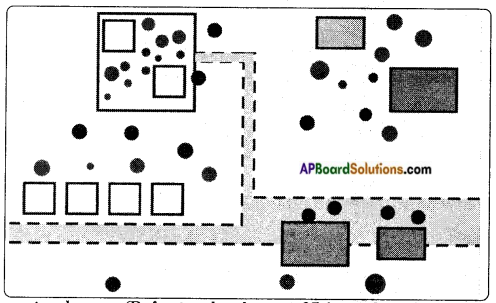
Answer:
Seven different colours. (Refer textbook page 85 for colours)
i) What does the colours indicate?
Answer: The colours indicate the existence of plants, animals, insects, humans, and birds,
ii) What does your total colour code count indicate?
Answer: Plants, animals, birds, insects live in our surroundings.
iii) What are the things that attract you very much in the nature?
Answer: Bird’s nests, cobwebs, worms, leaves, insects, mosses etc attract us.
iv) Write your feelings without any hesitation.
Answer: Enjoyment, happiness and pleasure.
Activity – 3
Question 2.
Variations in plants.
Answer:

Similarities:
- Paddy and Maize belong to grass plants.
- Both of them have same root system (fibrous R.S.)
- They are green colour.
- Seeds are enclosed.
- They produce cereals.
Variations in Animals:
a) Do you find any differences between animals?
Answer:
They show difference in colour of fur, nails, claws, hoofs etc.
b) Do you find any differences among birds?
Answer:
Birds have differences in their feathers, feet, crown, tail etc.
Variations in Human beings:
a) Observe two students of your class. Do they appear similar?
Answer:
No. Human beings show differences in their height & shape, hands, fingers, toes, nails and hair.
The texture of skin also may be dry, oily, smooth or rough.
b) Suppose two of your classmates happen to be twins, will they look same in structure and shape.
Answer:
If they are twins also we find little differences.

Activity – 4
Question 3.
Collect and paste some pictures of your favourite cricket players belonging to countries like West Indies, Australia, India, etc. in your note book.
Write the differences and similarities that you have noticed in them. What diversity you observed?
Display your finding of above activity in the class and discuss the following questions.
a) Are there any two organisms with 100% similarities between them?
Answer:
No, there are no organisms with 100% similarities.
b) Why do they differ from each other?
Answer:
Because they belong to different species.
c) What will happen if all plants are creepers?
Answer:
If all plants are creepers there will be no shelter for many birds and animals.
d) Hen and goat both have legs. What diversity do you find between them?
Answer:
Hen is a bird and goat is an animal. So hen has two legs and goat has 4 legs.
e) Are all the nests of birds similar why?
Answer:
Because of their living conditions and food habits, the nests of birds are not similar.
f) Do animals all around the world have similar organs and functions? What is the diversity behind them?
Though they look similar, upon careful observation we find differences or variations between them that leads to Biodiversity.
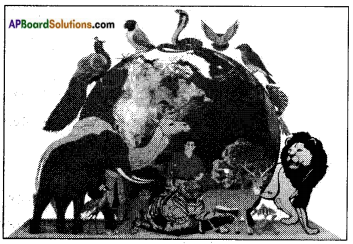
There is no mononamy or uniqueness in structure and functions of nature.
Diversity is the nature’s way.
Activity – 5 (Project work)
Question 4.
Studying migration and its effect on biodiversity of an area.

Read the following ways to conserve biodiversity try to enrich this list in your own way.
1. Look at the sky in the morning and evening. Do you observe birds flying in groups ?
Answer:
Yes. We can see birds flying in the sky in the morning and evening in groups.
2. Did you get the same number and types of birds every day?
Answer:
No. Some times more and some times less in number.
3. Was there any sudden variation in a particular season?
Answer:
Particularly in winter season we can see large number of birds flying in the sky.
4. Did you notice any new type of bird population in any season?
Answer:
During rainy season most of the birds from far away places migrate to Kolleru and Pulikot lakes of our states.
5. Why do these birds move from one place to another?
Answer:
Birds move from one place to another for food and shelter (nestling habits)
6. Sometimes at night we see birds flying in groups. Where do you think they fly to?
Answer:
Sometimes to protect themselves from climatic conditions, for food, for reproduction and to escape from hunting and also due to deforestation, we see birds flying in groups.
7. Perhaps the most important value of biodiversity, particularly in a country like India. Is that it meets the basic survival needs of a vast number of people.
Answer:
Cereals, pulses, oil seeds, sugars, spices, drugs, fibres, coir, timber, resins, gums, fruits, vegetables, dyes are obtained from plants. Meat, skin and hair are obtained from animals.
Like this the biodiversity in our country meets the basic survival needs of a vast number of people.
Flora and Fauna are renewable resources and are to be use judiciously.

Activity – 6 (Project work)
Question 5.
How to make recycled newspaper from waste newspapers? (OR)
Write the procedure of preparation of recycled paper which you did in your school lab.
Answer:
Materials:
2 plastic tubs, wooden spoon, water, clean cotton cloth, old news paper, wire screen, measuring cup, plastic wrap, blender, heavy books / roller.
Procedure:
- Add cut news papers strips in a tub full of water and soak it for a day.
- Put two cups of soaked paper and six cups of water in a blender. Blend till the mixture turns into a pulp (like nanny oat meal).Pour it in a clean tub.
- Fill the tub with one fourth of blended paper pulp.
- Lay a cloth on a flat, waterproof surface. Slide the wire screen under the wet paper. Remove the screen gently. Press the news paper pulp to squeeze out any extra water.
- Carefully flip the screen onto the cloth. Press it down firmly. Remove the screen.
- Lay another cloth on top of the mixture. Cover the cloth with a plastic wrap and stack the books on the wrap.
- After several hours remove the books on the cloth and let the paper dry.
- You can even use a hair dryer to blow the paper dry.
- By adding few drops of edible colours to the pulp you can make your paper colourful. Iron the new made paper with a iron box and cut it to your required size and shape.
- Beautiful greeting cards, file covers, bags etc., can be made using recycled paper.

Question 6.
How is a compressed cardboard prepared?
Answer:
Materials: bits of wood, saw dust and chemicals sulphate.
Producer:
- The pulp is made by using bits of wood.
- It is spead evenly as layers.
- The saw dust is sandwiched between the two layers.
- This is compressed and dried.
- It becomes hard and strong as wooden board.
- Hence there is no need to cut down the whole tree. This helps in reducing deforestation.
![]()
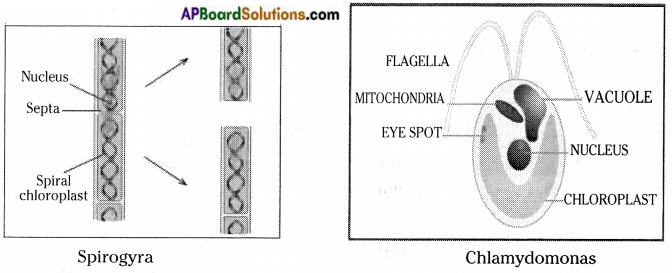
![]()
![]()

![]()
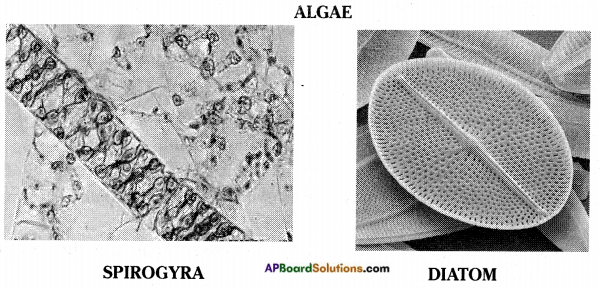


![]()
